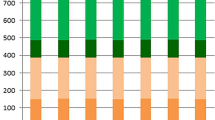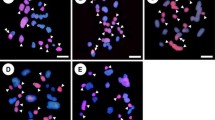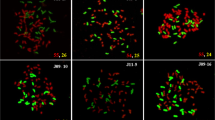Abstract
Although most of the hybrid embryos aborted at an early developmental stage, a 2n = 27 true intergeneric hybrid between Dendranthema indica (L.) Des Moul (2n = 36) as ♀ and Crossostephium chinense (L.) Makino (2n = 18) as ♂ was produced following pollination and ovule rescue. The morphology of the resulting adult putative hybrid and the two parents differed significantly from one another in seven of the nine traits measured, the exceptions being leaf width and leaf length, for which the putative hybrid was indistinguishable from the maternal plant. Genomic in situ hybridization experiments were able to successfully distinguish the genomic origin of both mitotic and meiotic metaphase chromosomes in the hybrid. In addition, the 18 D. indica chromosomes were paired as bivalents at meiotic metaphase in the hybrid.






Similar content being viewed by others
References
Abd El-Twab MH, Kondo K (1999) Identification of nucleolar organizing regions and parental chromosomes in F1 hybrid of Dendranthema japonica and Tanacetum vulgare simultaneously by fluorescence in situ hybridization and fluorescence genomic in situ hybridization. Chromosom Sci 3:59–62
Abd El-Twab MH, Kondo K (2001a) Genome territories of Dendranthema horaimontana in mitotic nuclei of F1 hybrid between D. horaimontana and Tanacetum parthenium. Chromosom Sci 5:63–71
Abd El-Twab MH, Kondo K (2001b) Molecular cytogenetic identification of the parental genomes in the intergeneric hybrid between Leucanthemella linears and Nipponanthemum nipponicum during meiosis and mitosis. Caryologia 54(2):109–114
Abd El-Twab MH, Kondo K (2002) Physical mapping of 5S rDNA in chromosomes of Dendranthema by fluorescence in situ hybridization. Chromosom Sci 6:13–16
Abd El-Twab MH, Kondo K (2004) Identification of parental chromosome of artificial intergeneric F1 hybrid between Dendranthema horaimontana and Nipponanthemum nipponicum by fluorescence in situ hybridization (GISH) and fluorescence in situ hybridization (FISH). Chromosom Sci 8:71–79
Abd El-Twab MH, Kondo K (2006) Fluorescence in situ hybridization and genomic in situ hybridization to identify the parental genomes in the intergeneric hybrid between Chrysanthemum japonicum and Nipponanthemum nipponicum. Chromosom Bot 1:7–11
Abd El-Twab MH, Kondo K (2007a) Isolation of chromosomes and mutation in the interspecific hybrid between Chrysanthemum boreale and C. vestitium using fluorescence in situ hybridization and genomic in situ hybridization. Chromosom Bot 2:19–24
Abd El-Twab MH, Kondo K (2007b) Meiotic chromosome organization and segregation in F1 intergeneric hybrid between Chrysanthemum horaimontanum and Nipponanthemum nipponicum by GISH identification. Chromosom Bot 2:121–125
Abd El-Twab MH, Kondo K, Hong DY (1999) Isolation of a particular chromosome of Ajania remotipinna in a chromosome complement of an artificial F1 hybrid of Dendranthema lavandulifolia × Ajania remotipinna by use of genomic in situ hybridization. Chromosom Sci 3:21–28
Anamthawat-Jónsson K, Schwarzacher T, Leitch AR, Bennett MD, Heslop-Harrison JS (1990) Discrimination between closely related Triticeae species using genomic DNA as a probe. Theor Appl Genet 79:721–728
Bremer K, Humphries CJ (1993) The generic monograph of the Asteraceae–Anthemideae. Bull Na Hist Museum London (Botany) 23:71–177
Doyle JJ, Doyle JL (1987) A rapid DNA isolation procedure for small quantities of fresh leaf tissue. Phytochem Bull 9(1):11–15
Fukai S, Nagira T, Goi M (2000) Cross compatibility between Chrysanthemum (Dendranthema grandiflorum) and Dendranthema species. Acta Hortic 508:337–340
Gallardo MH, González CA, Cebrián I (2006) Molecular cytogenetics and allotetraploidy in the red vizcacha rat, Tympanoctomys barrerae (Rodentia, Octodontidae). Genomics 88:214–221
Han FP, Liu G, Fedak G, Liu ZH (2004) Genomic constitution and variation in five partial amphiploids of wheat Thinopyrum intermedium as revealed by GISH, multicolor GISH and seed storage protein analysis. Theor Appl Genet 109:1070–1076
Herrero A, Pajarón S, Prada C (2001) Isozyme variation and genetic relationships among taxa in the Asplenium obovatum group (Aspleniaceae, Pterydophyta). Am J Bot 88:2040–2050
Heslop-Harrison JS, Schwarzacher T, Anamthawat-Jonson K, Leich AR, Shi M, Leich IJ (1991) In situ hybridization with automated chromosome denaturation. Technique 3:109–116
Hoffmann O (1894) Compositae. In: Engler A, Pranntl K (eds) Die Naturlichen Pflanzenfamilien (Berlin) 4(5):87–391
Iwatsuki K, Yamazaki T, Boufford DE, Ohba H (1995) Flora of Japan. III. Angiospermae Dicotyledoneae Sympetalae (b). Kodansha Ltd., Tokyo, pp 79–97
Kondo K, El-Twab MHA (2002) Analysis of inter- and intra-generic relationships sensu stricto among the members of Chrysanthemum sensu lato by using fluorescent in situ hybridization. Chromosom Sci 6:87–100
Kondo K, El-Twab MHA, Tanaka R (1999) Fluorescence in situ hybridization identifies reciprocal translocation of somatic chromosomes and origin of extra chromosomes by an artificial, intergeneric hybrid between Dendranthema japonica and Tanacetum vulgare. Chromosom Sci 3:15–19
Li H-J (1993) Chrysanthemum in China [M]. Jiangsu Scientific and Technical, Nanjing, pp 5–10 (in Chinese)
Li G-Q (2001) The basic research of cytology [M]. China Forestry, Beijing, pp 145–150
Ma XF, Gustafson JP (2005) Genome evolution of allopolyploids: a process of cytological and genetic diploidization. Cytogenet Genome Res 109:236–249
Ma N, Li Z-Y, Cartagena JA, Fukui K (2006) GI SH and AFLP analyses of novel Brassica napus lines derived from one hybrid between B. napus and Orychophragmus violaceus. Plant Cell Rep 25:1089–1093
Moore G (2002) Meiosis in allopolyploids: the importance of ‘Teflon’ chromosomes. Trends Genet 18:456–463
Murashige T, Skoog F (1962) A revised medium for rapid growth and bioassays with tobacco tissue cultures. Physiol Plant 15:473–497
Nakata M, Tanaka R, Taniguchi K, Shimotomai N (1987) Species of wild Chrysanthemum in Japan: cytological and cytogenetical view on its entity. Acta Phytotax Geobot 38:241–259
Ogura H, Kondo K (1998) Application of genomic in situ hybridization to the chromosome complement of the intergeneric hybrid between Leucanthrmella linearis (Matsum.) Tzuvelev and Nipponanthemum nipponicum (Franch. et Maxim.) Kitamura. Chromosom Sci 2:91–93
Ohishi K, Hasegawa T, Itakura N, Kawai A (1996) Morphological characteristics and fertility of F1 hybrid of Dendranthema grandiflora and Nipponanthemum nipponicum. J Jpn Soc Hortic Sci 65(Suppl 2):510–511 (in Japanese)
Perrie LR, Brownsey PJ, Lockhart PJ, Large MF (2003) Evidence for an allotetraploid complex in New Zealand Polystichum (Dryopteridaceae). N Z J Bot 41:189–215
Poggio L, González G, Confalonieri V, Comas C, Naranjo CA (2005) The genome organization and diversification of maize and its allied species revisited: evidence from classical and FISH–GISH cytogenetic analysis. Cytogenet Genome Res 109:259–267
Riley R, Chapman V (1958) Genetic control of the cytologically diploid behaviour in hexaploid wheat. Nature 182:713–715
SYSTAT (1997) SYSTAT, version 7.0. SPSS Inc., Chicago
Takahashi C, Leitch IJ, Ryan A, Bennett MD, Brandham PE (1997) The use of genomic in situ hybridization (GISH) to show transmission of recombinant chromosomes by a partially fertile bigeneric hybrid, Gasteria lutzii × Aloe aristata (Aloaceae), to its progeny. Chromosoma (Berl.) 105:342–348
Tanaka R, Watanabe K (1972) Embryological studies in Chrysanthemum makinoi and its hybrid crossed with hexaploid Ch. japonense. J Sci Hiroshima Univ Ser B Div (Bot) 14:75–84
Watanabe K (1977) Successful ovary culture and production of F1 hybrids and androgenic haploids in Japanese Chrysanthemum (Compositae). Jpn J Genet 52:124–131
Watanabe K (1981a) Studies on the control of diploid-like meiosis in polyploid taxa of Chrysanthemum. I. Hexaploid Ch. Japonense Nakai. Cytologia 46:459–498
Watanabe K (1981b) Studies on the control of diploid-like meiosis in polyploid taxa of Chrysanthemum. II. Octoploid Ch. ornatum Hemsley. Cytologia 46:499–513
Watanabe K (1981c) Studies on the control of diploid-like meiosis in polyploid taxa of Chrysanthemum. III. Decaploid Ch. crassum Kitamura. Cytologia 46:515–530
Watanabe K (1983) Studies on the control of diploid-like meiosis in polyploid taxa of Chrysanthemum. Theor Appl Genet 66:9–14
White S, Doebley J (1998) Of genes and genomes and the origin of maize. Trends Genet 14:327–332
Zhang H-Q, Croes AF (1982) A new medium for pollen germination in vitro. Acta Botan Neerland 31:113–119
Zhao H-B, Chen F-D, Fang W-M (2005) Pollen germination in vitro of Chrysanthemum cultivars with small inflorescences and several species of Dendranthema. J Nanjing Agric Univ 28(2):22–27
Zhao H-B, Chen F-D, Guo W-M, Tang F-P, Fang W-M (2008) Intergeneric cross-compatibility between Dendranthema and some genus of tribe Anthemideae. J Nanjing Agric Univ 31(2):139–143
Acknowledgments
This work was supported by the Program for New Century Excellent Talents in University of Chinese Ministry of Education (grant no. NCET-06-0489), the National Key Technology R&D Program of the Ministry of Science and Technology of the People’s Republic of China (grant no. 2006BAD01A1806), and the Shanghai Key Science and Technology for Agriculture Promotion program (2006 no. 4-3).
Author information
Authors and Affiliations
Corresponding author
Rights and permissions
About this article
Cite this article
Tang, F., Chen, F., Chen, S. et al. Molecular cytogenetic identification and relationship of the artificial intergeneric hybrid between Dendranthema indica and Crossostephium chinense by GISH. Plant Syst Evol 289, 91–99 (2010). https://doi.org/10.1007/s00606-010-0337-7
Received:
Accepted:
Published:
Issue Date:
DOI: https://doi.org/10.1007/s00606-010-0337-7




